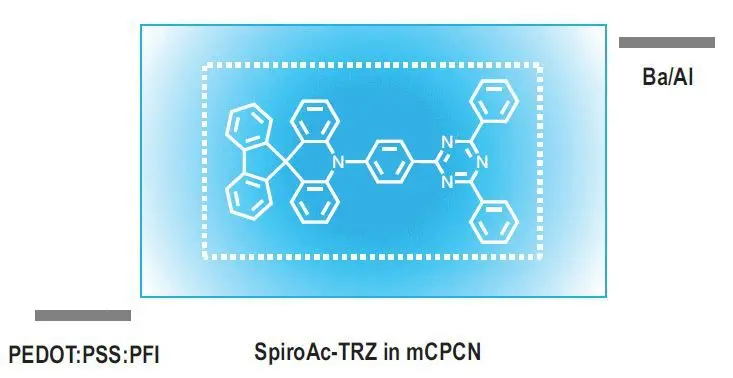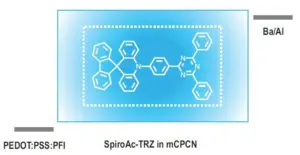In what is represented as a first, a team of researchers headed by Oskar Sachnik of the Max Planck Institute for Polymer Research (Mainz, Germany) have developed a single layer OLED. One obvious advantage of this new approach is that it is a much simpler design than current, commercially available OLED devices that use multilayer stacks. This should make manufacturing the new device easier and less expensive.
Here is a few words of background information.
Back in about 1987 when first developed, the configuration of OLEDs consisted of a semiconducting layer sandwiched between two electrodes. It was soon discovered that a considerable gain in efficiency was possible by increasing the number of functional layers. Unfortunately, there was a major drawback in implementing multilayer OLEDs. The complexity of their design resulted in difficulties in device fabrication and this, in turn, drove up manufacturing costs. More specifically, it was found that multilayer OLEDs could not be fabricated with the preferred means of fabrication: a simple, inexpensive solution process. Furthermore, the additional layers frequently induced voltage losses and were a potential source of device degradation.
There is, therefore, a real incentive to develop a simplified OLED device structure with an efficiency comparable to that of multilayer configurations. The approach adopted by the researchers to achieve this goal is discussed in a recent article.
The researchers developed a single layer, blue light emitting OLED based on a yellow TADF emitting layer blended with a host in equal ratios. (TDAF stands for Thermally Activated Delayed Fluorescence. TDAF is a process through which a molecular species in a non-emitting excited state can incorporate surrounding thermal energy to change states and only then undergo light emission.) The TDAF layer, composed of SpiroAc-TRZ:mCPCN (1:1), was sandwiched between a PEDOT:PSS:PFI hole contact and a barium/aluminum metal top electrode. A graphic illustration of the device configuration is presented in the figure below.

Although the device prototyped by the team did not include any charge transport or blocking interlayers, the ohmic contacts did required tunneling interlayers. These consisted of organic-semiconductor layers a few nanometers thick. In their article, the researchers admit that coating steps are still required to deposit these interlayers and that this is suboptimal for vacuum deposited OLEDs. Of greater significance is the fact that it would be an additional hurdle to overcome if fabricating OLEDs utilizing only solution processing.
Test and measurement of the prototype single layer OLED device indicated that almost every injected electron was converted into a photon – that is, the device had almost 100% internal quantum efficiency. Furthermore, the new configuration exhibited an external quantum efficiency of 27.7%, a low operating voltage and had a low efficiency roll-off at high brightness.
These results are claimed to demonstrate that highly simplified, single layer OLEDs are a feasible alternative to state-of-the-art multilayer devices. More than that, the team suggests that their success in utilizing a solution processed hole contact lays the foundation for efficient single layer OLEDs fabricated solely with solution processes.
The next steps for the researchers are to improve the stability/lifetime of the device and improve the light outcoupling.
The researchers conclude their article with the speculation that their “research could have far reaching implications, as it could lead to lower cost OLED production, which requires only the emitter and the electrodes without the deposition of other layers.”
Reference
Sachnik, O., Li, Y., Tan, X., Michels, J.J., Blom, P.W.M. and Wetzelaer, G.-J.A.H. (2023), Single-Layer Blue Organic Light-Emitting Diodes With Near-Unity Internal Quantum Efficiency. Adv. Mater. 2300574. https://doi.org/10.1002/adma.202300574

